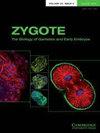温度对铁饼鱼(Symphysodon aequifasciatus)胚胎和幼鱼发育的影响以及首次摄食的时间
IF 1.4
4区 生物学
Q4 CELL BIOLOGY
引用次数: 0
摘要
摘要 本研究旨在分析不同温度对铁饼鱼(Symphysodon aequifasciatus)胚胎和幼体发育的影响,并确定开始外源喂养所需的时间。鱼卵和幼体取自自然产卵,分为五个处理:24.0、26.0、28.0、30.0 和 32.0 °C。为评估发育阶段和胚胎结构,每隔一定时间取样并在光学显微镜下检查。实验结束后,进行统计分析,并进行 Tukey's 检验。结果显示,温度对变量有显著影响。实验结果表明,温度加快了铁饼的胚胎和幼体发育,也缩短了孵化期与摄食过渡期之间的时间。研究还注意到,在 24.0 °C的温度下孵化鱼卵和幼体会对胚胎造成损害,如身体畸形和循环系统异常。本文章由计算机程序翻译,如有差异,请以英文原文为准。
Effect of temperature on the embryonic and larvae development of discus fish Symphysodon aequifasciatus and time of first feeding
Summary This study aimed to analyze the influence of different temperatures on the embryonic and larval development of discus fish Symphysodon aequifasciatus and determine the time required for the beginning of exogenous feeding. Eggs and larvae were obtained from natural spawns and distributed in five treatments: 24.0, 26.0, 28.0, 30.0, and 32.0 °C. To assess the developmental stages and embryonic structures, samples were taken at regular intervals and checked under an optical microscope. At the end of the experimental period, statistical analysis was performed, followed by Tukey’s test. As a result, it was possible to observe the significant effects of temperature on the variables. It was noted that the temperature accelerated the embryonic and larval development of the discus and also contributed to a reduction in the time between the incubation period and the feeding transition. It was also noted that the incubation of eggs and larvae at a temperature of 24.0 °C can cause damage to embryos, such as malformation of the body as well as anomalies in the circulatory system.
求助全文
通过发布文献求助,成功后即可免费获取论文全文。
去求助
来源期刊

Zygote
生物-发育生物学
CiteScore
1.70
自引率
5.90%
发文量
117
审稿时长
6-12 weeks
期刊介绍:
An international journal dedicated to the rapid publication of original research in early embryology, Zygote covers interdisciplinary studies on gametogenesis through fertilization to gastrulation in animals and humans. The scope has been expanded to include clinical papers, molecular and developmental genetics. The editors will favour work describing fundamental processes in the cellular and molecular mechanisms of animal development, and, in particular, the identification of unifying principles in biology. Nonetheless, new technologies, review articles, debates and letters will become a prominent feature.
 求助内容:
求助内容: 应助结果提醒方式:
应助结果提醒方式:


